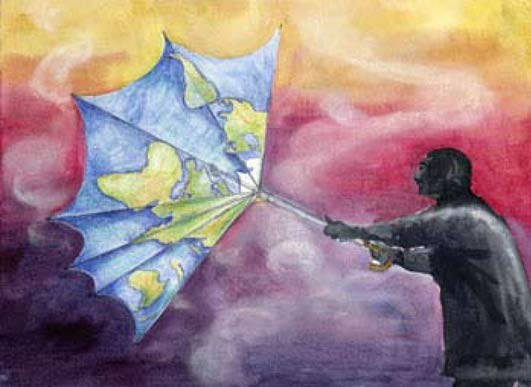Warm and near-comfortable this Monday afternoon here in California’s Central Valley as climate’s weather plays games. The dry-red air present the last few days from the state’s wildfires has lessened a good bit and the heat feels near-about normal, whatever the shit ‘normal‘ is nowadays.
Climate change currently is front and center, too, mainly due to disaster after disaster. Although we here in California (and other SW US states) are suffering a huge-lack-of-water drought, many parts of the world have way-more than enough, and the situation is only going to just get worse:
Record rainfall that triggered deadly floods in Western Europe in July was made between 1.2 and 9 times more likely by human-caused climate change, according to a new study https://t.co/Hqw2X3R1Y2
— CNN (@CNN) August 23, 2021
Details via the CNN link:
Record rainfall that triggered deadly floods in Western Europe in July was made between 1.2 and 9 times more likely by human-caused climate change, according to a new study.
At least 220 people were killed between July 12 and 15 — mostly in Germany, though dozens also died in Belgium — and homes and other buildings were destroyed in flash flooding that followed heavy rainfall. Some parts of the region experienced more rain in a single day than they would typically expect in a whole month.
The study, conducted by 39 scientists and researchers with the World Weather Attribution (WWA) project, also found that the most extreme rain was a once-in-400-year event, and that climate change increased the intensity of daily extreme rainfall by 3percent to 19-percent.
“These floods have shown us that even developed countries are not safe from severe impacts of extreme weather that we have seen and known to get worse with climate change,” Friederike Otto, the associate director of the Environmental Change Institute at the University of Oxford, said in a statement.
“This is an urgent global challenge and we need to step up to it. The science is clear and has been for years.”
Climate science closer to home and more-right now — again CNN this afternoon:
In New York, downpours from Hurricane Henri set rainfall records this weekend. At the same time in Tennessee, an astonishing amount of rain led to flash flooding that killed at least 21 people.
Though separated by nearly 1,000 miles, these two extreme weather incidents are examples of the same phenomenon: human-caused climate change supercharging extreme rainfall events. And these types of extreme rainfall events are likely to become more common, too, as long as the planet continues to get hotter.
The reason is based on a physics principle known as the Clausius-Clapeyron relationship, which relates temperature, pressure and water vapor.
The principle shows that warmer air can hold more water vapor — about 7-percent more water vapor per 1 degree Celsius.
More water vapor in the atmosphere means more moisture available to fall as rain, which leads to higher rainfall rates.
On average, the planet has already warmed more than 1-degree Celsius since pre-industrial times, according to a major UN climate change report published earlier this month.
Overland areas there has been even more warming, and particularly in the Eastern US, which has led to a noticeable increase in heavy downpours that lead to flash flooding, according to the most recent National Climate Assessment.
Further on the Tennessee flooding from The New York Times, also this afternoon:
WAVERLY, Tenn. — With floodwaters rising rapidly, 15-year-old Lily Bryant and her older sister managed to find some wooden debris to cling to, but it offered only short-term relief.
The makeshift raft hit a tree and split in two.“Lily went one way and her sister went the other way, and no one has seen her since,” said Tarry Lynn Gillinger Holderman, Lily’s aunt.
“She was washed away because the current was so strong.”Lily’s sister, Kailynne, 19, made it to safety; Lily is missing.
Kailynne, Ms. Holderman said, is devastated.
“She blames herself.”The scale of the destruction from the weekend’s storm in Tennessee came into grim relief on Monday, as emergency workers and those who escaped the worst spent the day searching for loved ones.
At least 21 people were confirmed dead and about 10 others remained missing, officials said, in catastrophic flash flooding that climate scientists warned will become only more common.In the past 48 hours, parts of Tennessee have been swept by record-breaking rainfall and unexpected flash flooding that has killed at least 21 people and left dozens missing.
“This is exactly the type of event we expect to see with increasing frequency in a warming climate,” said Gary Lackmann, a professor of atmospheric science at North Carolina State University.
As in so many different parts of the world nowadays, immeasurable horror-tragedies galore.
Added note on the flooding (The Washington Post this afternoon):
Inland flooding is the leading cause of death associated with tropical cyclones in the past 50 years, according to the Federal Emergency Management Agency.
On average, damage from inland floods costs more than any other severe weather event. It’s a problem from the mountains of western North Carolina, where Tropical Storm Fred killed five people last week, to the streets of Dearborn, Mich., where heavy rains have repeatedly overwhelmed the sewer systems and destroyed homes.“There is no place in the United States where you shouldn’t be resetting your expectations about Mother Nature disrupting your life,” said Roy Wright, president of the Insurance Institute for Business and Home Safety and former head of FEMA’s National Flood Insurance Program.
“Climate change has come barging through the front doors of America.”
Politics of the environment.
Dumb, but effective — although flooding, this from sea-level rise:
And again, here we are…
 (Illustration out front from the UN’s International Children’s Painting Competition, and found here).
(Illustration out front from the UN’s International Children’s Painting Competition, and found here).